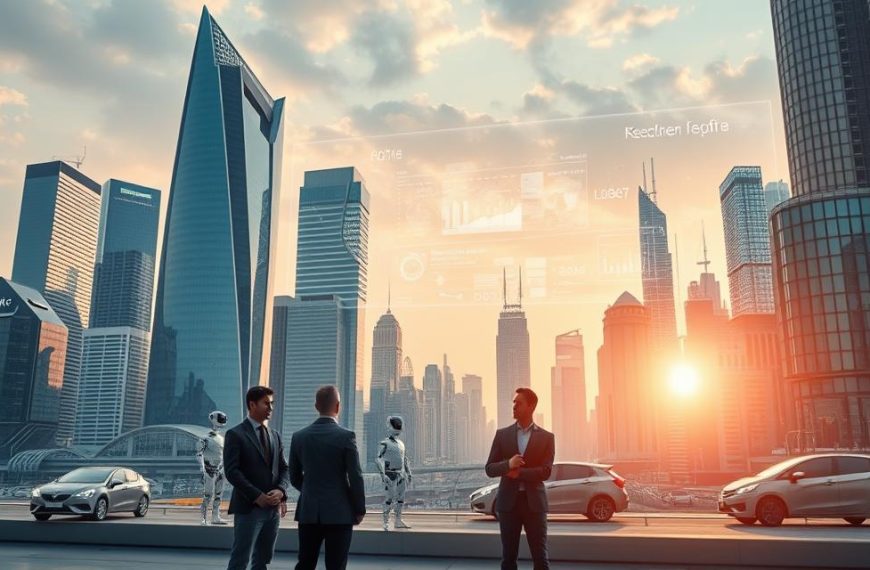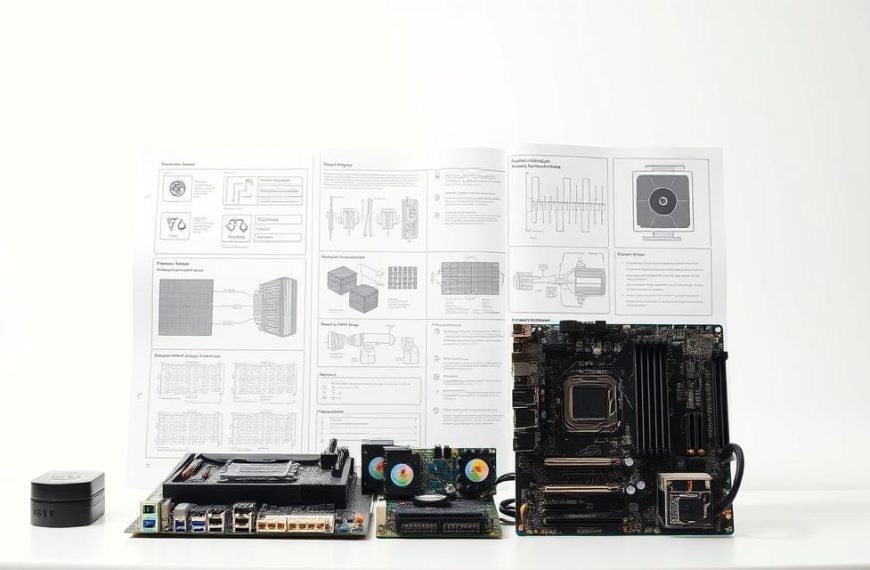Technologies powered by advanced algorithms are reshaping industries at an unprecedented pace. The global market for these solutions is projected to grow at 38.1% annually through 2030, signaling massive adoption across sectors.
From banking to construction, organizations see tangible benefits. Financial institutions could gain $1 billion+ in value by 2035, while builders achieve 50% productivity jumps through optimized processes. Over three-quarters of companies now actively implement these tools.
Two primary drivers fuel adoption: operational efficiency (56% of implementations) and customer experience (46% CRM usage). Retailers, healthcare providers, and financial firms lead the charge, as detailed in our business transformation guide.
While automation affects certain roles, these technologies also create new opportunities. Research suggests a net 9% job growth by 2025, alongside helping achieve 93% of environmental targets through smarter resource use.
Forward-thinking organizations recognize the strategic advantage. Eighty percent of executives consider these innovations critical for maintaining competitiveness in evolving markets.
Understanding Artificial Intelligence and Its Business Applications
Modern enterprises leverage self-learning systems to unlock new efficiencies. These technologies process information differently than traditional software, adapting to patterns in massive datasets.
What Is AI? Beyond the Buzzword
Self-optimizing programs analyze information without explicit coding for every scenario. Neural networks, modeled after the human brain’s structure, identify complex relationships in data like medical scans or financial transactions.
Healthcare providers use these systems to detect tumors in X-rays with 95% accuracy. The technology examines thousands of historical cases to recognize subtle patterns invisible to human eyes.
Key AI Technologies: Machine Learning vs. Deep Learning
Machine learning improves through experience, like predicting equipment failures in factories. Sensors collect vibration and temperature data, alerting technicians before breakdowns occur.
Deep learning handles more complex tasks, such as autonomous vehicles processing road conditions. These systems evaluate multiple variables simultaneously – from pedestrian movements to weather changes.
| Feature | Traditional Systems | AI Solutions |
|---|---|---|
| Data Capacity | 1 million row limit | Unlimited scalable processing |
| Learning Method | Static rules | Continuous self-improvement |
| Output Type | Predefined reports | Predictive insights |
TD Bank demonstrates practical application through hyper-personalized mortgage offers. Their system combines location data with spending patterns to suggest tailored financial products.
Marketing teams benefit through tools like HubSpot’s CRM, which drafts context-aware emails. The platform analyzes customer interactions to recommend optimal messaging timing and content.
Energy providers achieve 15% consumption reductions using smart grids. These networks adjust power distribution based on real-time usage predictions from machine learning algorithms.
How Does Artificial Intelligence Impact Lines of Businesses?
From personalized shopping to life-saving diagnostics, self-learning tools are transforming core operations. Retailers, hospitals, and financial institutions report double-digit efficiency gains.
Retail: Personalization and Inventory Management
Amazon’s recommendation engines boost conversions by 35% using algorithms that analyze browsing history. Real-time data streams optimize inventory levels, reducing waste by 20%.
Chatbots handle 50% of customer service queries, freeing staff for complex issues. Hyper-targeted promotions now drive 60% of online sales.
Healthcare: Diagnostics and Patient Care
Cleveland Clinic’s remote monitoring systems cut readmissions by 25%. AI-powered transcriptions save clinicians 7 hours weekly, improving healthcare delivery.
Diagnostic tools detect tumors with 95% accuracy, leveraging historical data for faster, safer outcomes.
Banking: Fraud Detection and Customer Service
Capital One’s NLP models spot fraud detection patterns in milliseconds. Bank of America’s Erica chatbot resolves 50 million+ client interactions annually.
Automated loan approvals slash processing times from days to hours, enhancing customer satisfaction. Robotic process automation (RPA) reduces errors by 45%.
AI-Driven Efficiency in Core Business Functions
Operational excellence now hinges on strategic implementation of cognitive technologies. Eighty-three percent of companies prioritize these solutions in strategic planning, recognizing their potential to transform workflows. Mining firms already see 18x faster data processing, while the accounting automation market grows toward $161.8 million.
Automating Repetitive Tasks for Higher Productivity
UiPath’s robotic process automation slashes invoice processing time by 70%. This mirrors broader trends where 62% of organizations automate document handling. HR departments leverage tools like HireVue to screen candidates 5x faster.
Financial reporting errors drop 32% when manual tasks transition to automated systems.
“The productivity gains from process automation allow teams to focus on strategic work,”
notes a Deloitte operations analyst.
Data Analytics: From Insights to Actionable Strategies
Walmart’s supply chain runs on predictive analytics that forecast demand with 90% accuracy. Their systems analyze petabytes of sales data to optimize inventory placement.
Tableau’s AI-assisted visualization tools help manufacturers identify production bottlenecks. These solutions turn complex datasets into clear operational insights. Efficiency improvements often exceed 15% in optimized facilities.
ERP systems now embed machine learning to streamline manufacturing processes. Real-time data analytics enable dynamic adjustments that reduce downtime by 40% in some plants.
The Role of AI in Customer Experience and Engagement
Customer expectations are evolving faster than ever, and businesses must adapt quickly. Advanced tools now enable brands to deliver seamless, personalized interactions at scale. Over 50% of consumers prefer chatbots for instant support, while predictive analytics power recommendations that boost loyalty.
Chatbots and 24/7 Support Systems
Sephora’s virtual assistant drives 11% higher conversions by guiding shoppers to ideal products. These tools resolve queries 3.5x faster than human agents, as seen with Bank of America’s Erica chatbot handling 50 million+ yearly interactions.
Key benefits include:
- Cost savings: Chatbots reduce service expenses by 30% while improving satisfaction (Forbes).
- Accuracy: Domino’s voice-ordering AI achieves 95% precision, streamlining transactions.
Hyper-Personalization Through Predictive Analytics
*Starbucks’ Deep Brew* system analyzes purchase history to suggest customized drinks, increasing order frequency. Similarly, Netflix’s recommendation engine saves $1 billion annually by keeping viewers engaged.
CRM platforms like Salesforce Einstein GPT use sentiment analysis to refine outreach. This boosts Net Promoter Scores (NPS) by 15 points, proving that data-driven strategies enhance long-term relationships. By 2024, 85% of businesses will rely on AI for primary customer interactions.
AI in Emerging Industries: Construction, Mining, and Beyond
Emerging industries like construction and mining are harnessing AI to solve long-standing challenges. These sectors now achieve 50% productivity gains and 40% higher safety compliance, proving the value of smart technologies in high-risk environments.
Smart Equipment and Safety Enhancements
Komatsu’s AI-driven bulldozers detect obstacles autonomously, reducing accidents by 25%. Caterpillar uses predictive maintenance to analyze equipment data, cutting downtime by 30%.
Mining firms deploy smart helmets with fatigue detection. These systems alert workers when vitals indicate danger, improving onsite safety.
| Feature | Traditional Safety | AI-Enhanced Safety |
|---|---|---|
| Hazard Detection | Manual inspections | Real-time sensors |
| Response Time | Minutes–hours | Seconds |
| Compliance Rate | 60% | 90%+ |
Real-Time Data for Decision-Making
Procore’s AI analyzes construction documents, reducing rework costs by 18%. Rio Tinto’s Autonomous Haul systems use real-time fuel analytics, saving millions annually.
BIM software identifies design flaws early, while drones improve inspection accuracy by 35%. These tools streamline management and resource allocation.
“AI transforms raw data into actionable insights, letting teams act before problems arise.”
Challenges and Ethical Considerations of AI Adoption
Balancing innovation with responsibility remains a critical challenge in AI adoption. While automation boosts efficiency, it also raises questions about fairness, accountability, and long-term societal impacts. Over *85% of consumers* demand safety assurances, and regulators increasingly scrutinize algorithmic decisions.
Workforce Displacement vs. Job Creation
By 2025, automation may displace 16% of roles but create only 9% new jobs, per McKinsey. However, retraining programs like Google’s AI certifications help workers transition. Hybrid models—where workforce teams collaborate with tools—show promise.
| Hiring Factor | Traditional Methods | AI-Augmented Approach |
|---|---|---|
| Bias Risk | Human subjectivity | Algorithmic audits (e.g., IBM’s toolkit) |
| Speed | Weeks to screen | Hours with NLP analysis |
| Diversity | Limited by networks | Blinded candidate scoring |
Bias, Transparency, and Accountability
Amazon’s discontinued hiring tool, which favored male candidates, highlights bias risks. The EU AI Act now mandates transparency in high-risk systems. Microsoft’s responsible AI framework and ethical AI guidelines offer compliance blueprints.
Facial recognition disparities—error rates up to 34% for darker skin tones—underscore the need for diverse training data. Regular audits and explainable AI techniques mitigate these risks, ensuring equitable outcomes.
Conclusion
The transformative power of AI across industries is undeniable. Retail, healthcare, and finance lead the charge, achieving measurable gains in efficiency and customer satisfaction. Ethical frameworks and pilot programs remain critical for sustainable adoption.
By 2025, 70% of enterprises will integrate these tools, per Gartner. New roles like AI trainers and ethicists are emerging, emphasizing the need for workforce adaptation. AIaaS models are rising, offering scalable solutions for businesses of all sizes.
Strategic roadmaps should balance innovation with responsibility. Start small—test solutions in controlled environments before full deployment. The future belongs to those who harness data intelligently while prioritizing transparency.
Ready to transform your business? Assess your needs, explore tailored strategies, and take the first step today.



















